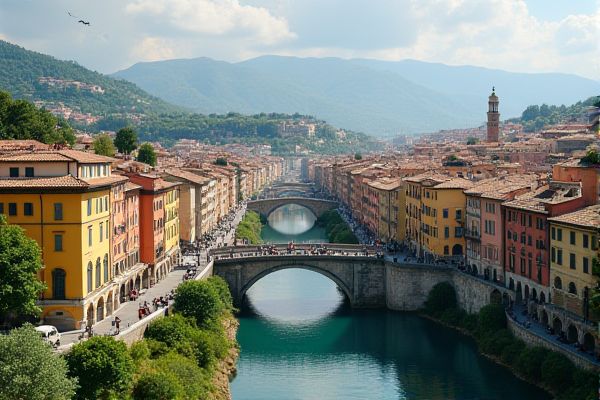
Weather and climate in Italy: Mediterranean climate dominates. Hot, dry summers. Mild, wet winters. Northern regions experience snowfall. Coastal areas rarely freeze. Alpine regions are cooler. Southern regions can be arid. Rainfall varies significantly by region. Spring and autumn are pleasant. Central Italy has clearer seasons.
Mediterranean climate dominates.
Italy's Mediterranean climate is characterized by hot, dry summers and cool, wet winters, with these conditions being particularly dominant in the southern regions. The warm Mediterranean Sea moderates temperatures, creating a pleasant environment that marks this climate zone. During summer, temperatures often reach between 28-33°C or even up to 40°C, with rare instances of snowfall in the south, while the north can experience cooler and more humid conditions. For more detailed insights, the Weather Online website provides comprehensive reports on Italy's climate.
Hot, dry summers.
In Italy, summers are generally hot and dry, especially in the southern regions, with average temperatures often reaching 23-28°C (73.4-82.4°F) and minimal rainfall during these months. The Mediterranean Climate prevalent in coastal areas and southern Italy characterizes these hot, dry summers, while the north can be more humid and cloudy.
Mild, wet winters.
In Italy, mild and wet winters are characteristic, especially in the coastal regions and the south, where temperatures are generally higher than in the north. The northern and mountainous areas experience cooler, wetter, and sometimes snowy winters. Meanwhile, the Po Valley and other inland regions have humid subtropical to humid continental climates with cool winters and hot summers. For more comprehensive information about the diverse Climate of Italy, exploring various regions provides insights into how geographical differences influence weather patterns across the country.
Northern regions experience snowfall.
Northern Italy has received record snowfall, particularly in the Alpine regions, with significant snowfall predicted, creating a winter wonderland ahead of autumn's official arrival and affecting areas such as Valle d'Aosta and the Alps. Snowfall in Northern Italy is common between early December and early March, with cities like Turin, Milan, and Bologna often experiencing snow during these months. This unprecedented climate phenomenon has caught many by surprise, as it echoes the [Extreme Weather Event](https://www.thetravel.com/extreme-weather-event-brings-record-snowfall-to-northern-italy-and-flooding-to-southern-italy/) currently impacting various regions across Italy. While Northern Italy becomes a picturesque vista enveloped in white, the contrasting weather in the south poses its own challenges, highlighting the dichotomy of Italian climate during this extraordinary period.
Coastal areas rarely freeze.
Coastal areas in Italy, including those in Southern Italy and the islands like Sicily and Sardinia, rarely freeze due to their Mediterranean climate. This climate is characterized by mild, wet winters and hot, dry summers, which makes these regions attractive for tourism and outdoor activities year-round. For more detailed information on different climate regions of Italy, you can visit the Climate Zones Of Italy website.
Alpine regions are cooler.
In Italy's Alpine regions, the climate is characterized by lower temperatures and higher rainfall, with harsh winter conditions and significant snowfall, especially in the eastern Alps where the snow line is lower and snowfall is more abundant than in the western Alps. The Dolomites, a part of the Alpine region, experience mild summers and cold, sunny winters, with rainfall concentrated in the summer months and a high percentage of sunny days in winter. For a more detailed exploration of these climatic patterns, visit the comprehensive resource on Italy's Climate.
Southern regions can be arid.
Southern Italy, particularly regions like Apulia, Basilicata, Calabria, Sicily, and Sardinia, are experiencing severe drought, with a significant portion of the territory affected by extreme drought, leading to soil degradation and increased risk of desertification. According to a thorough analysis from The Impact Of Climate Change In Southern Italy, these conditions are exacerbating existing environmental problems and posing a serious challenge to local agriculture, water supply, and biodiversity. This scenario calls for immediate and strategic interventions to mitigate the damaging effects of climate change and to sustain the livelihoods of those residing in these vulnerable regions.
Rainfall varies significantly by region.
Rainfall in Italy varies significantly by region, with the Alpine areas receiving higher rainfall - up to 1,055 mm at Cortina d'Ampezzo - compared to the southern regions, where it can be as low as 400 mm in Sardinia and Puglia. The [Tyrrhenian coast](https://www.britannica.com/place/Italy/Climate) is generally wetter than the Adriatic coast, highlighting the diverse climatic conditions found throughout the country. This variation in rainfall significantly influences the local agriculture, ecosystem, and lifestyle of the inhabitants.
Spring and autumn are pleasant.
Spring in Italy, from March to June, is characterized by pleasant and breezy weather with temperatures ranging from 5°C to 25°C, making it ideal for outdoor activities like sightseeing, hiking, and cycling. Autumn, from September to November, offers similar pleasant conditions with temperatures between 8°C and 28°C, though it can be rainy, especially in November, and is marked by significant cultural events like the Venice Film Festival and the San Gennaro Festival.
Central Italy has clearer seasons.
Central Italy, including regions like Tuscany and Umbria, experiences clearer seasons with hot summers, mild winters, and distinct spring and autumn periods. These areas are characterized by winter temperatures in the 40s and 50s Fahrenheit, while summer brings highs in the 80s Fahrenheit. For more detailed insights into the Climate In Italy, the pattern of the changing seasons offers a charming mix of weather that shapes the lifestyle and culture of these picturesque Italian landscapes.
